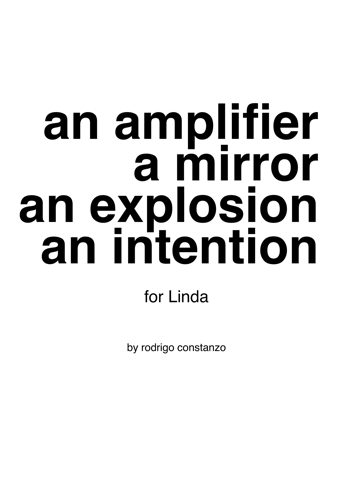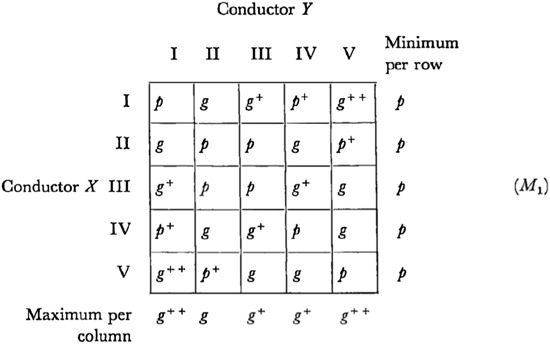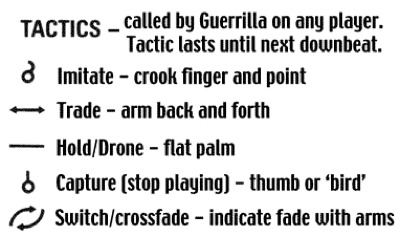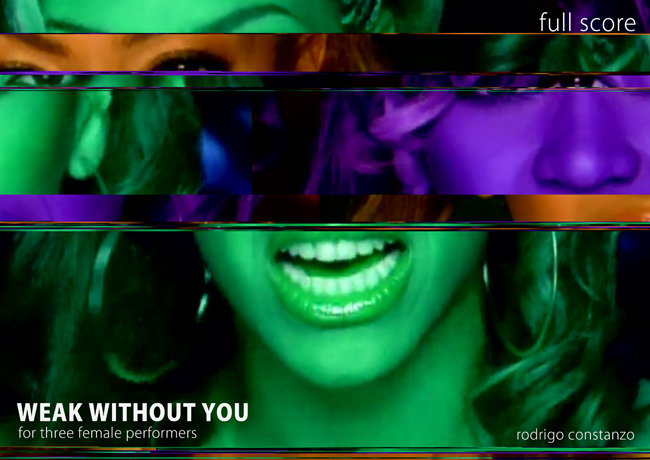strikethrough me & you – live
Some more me & you action, this time live. Oddly enough, even though we’ve been at this for a while, this was our first live performance. The set went really well, to a full house at The Noise Upstairs.
Still working on the mixes from the recording session at the end of last year and will release all the tracks for free once they are ready. For now here are a few of the performances from our first gig.
strikethrough me & you – in the studio
I’ve been working on a duet project (me & you) with Sam Andreae for well over a year now. We started shortly after he moved back to the UK after spending a couple of years in Scandinavia. It started off innocently enough, just as drum/sax free improv. That later blossomed into the idea for Battle Pieces. The idea is simple enough, a kind of challenge/battle/etude where we perform (often) against each other.
In content it is very similar to what I’ve been doing with other recent compositions (.com pieces, Everything., an amplifier) where I compose interaction, behavior, and relationships, instead of ‘content’. In the Battle Pieces the challenges are much more difficult and intense and have forced Sam and I to change/adapt/improve as improvisers drastically.
In December 2013 we decided we had enough of these pieces to go into the studio.
Before I run at the gob some more, here is Glitch Beat from the recording session:
We recorded 8 pieces total, with alternative takes being filmed by Angela Guyton on the second day in the studio.
I’ve become less interested in the idea of “releases” over the years, particularly since I hate getting CDs from people. I do like the art object of a release, which is why many of my releases over the years have been hand-made in one way or another, but even that idea has been waning. This has coincided with my increased video output, not so much as a kind of documentation, but as the thing itself. I do think that me & you is a live band, and we will play many gigs together, but as far as this recording goes, the current idea is to release each track individually, and for free. We’ve talked about eventually putting together a deck of cards with each piece written on each card, so at gigs we can pull out random cards and have our set determined that way, but we need to write many more pieces before we are at that point.

If the background looks familiar, it is because it is in the same studio where I recorded a follow up album with PA Tremblay in 2012. Due to PAs busy schedule, the recording is still in post, but it’s a doozy, and should hopefully be out in 2014.
My setup is equally stripped down, just being a 3-piece acoustic kit with 2 cymbals (1hat, 1ride), but after moving down to just a 2 piece setup, I’ve decided to add a single small (tiny) tom to complement the setup. I find that with me & you in particular, the alternate color of the tom works really well.
Here is one of our newer pieces, Flurries:
This piece is quite a departure for us in terms of sound world, but we’re both very happy with it. It was composed a couple of weeks before going into the studio, and the interactions were only finalized in the last rehearsal before the studio.
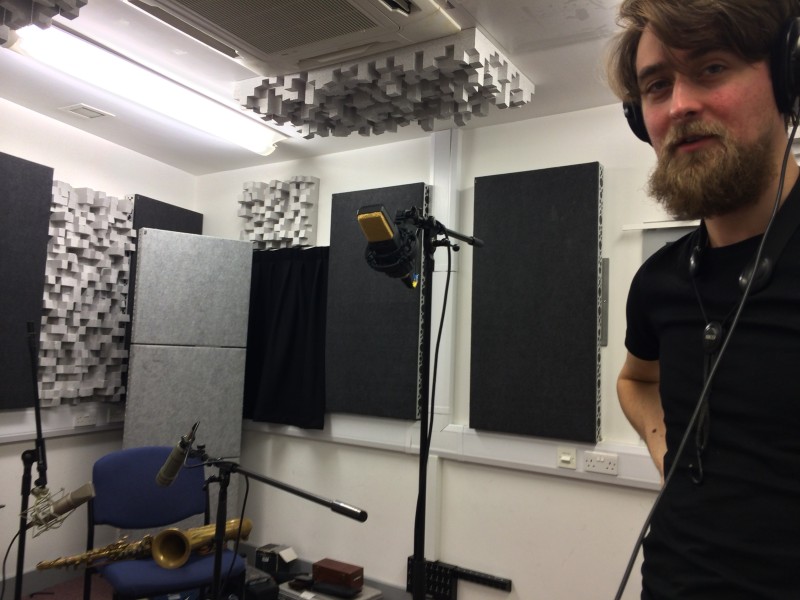
We have not finished ‘notating’ most of the pieces, which requires careful consideration of the wording, but here are 5 of the scores.
an amplifier, a mirror, an explosion, an intention
Early in 2013 a close friend of mine, Linda Jankowska, asked me to write her a violin piece. Despite her being an amazing and dedicated violinist, I told her no. I added “I don’t believe in violin”. I don’t think she had ever heard those words before….
Fast forward to now, the end of 2013. I still don’t believe in violin, but I wrote her a piece. The piece does not specify instrumentation. The instrumentation is simply “for Linda”.
Here enters : an amplifier, a mirror, an explosion, an intention
This piece is very different from the kinds of things I’ve been working on lately. One massive difference is that I’m not playing at all. The trajectory of my work, as of late, has been to compose/perform/improvise myself, or with very close collaborations in which I am also a performer.
The intellectual framework of the piece is also new. The .com pieces, Battle pieces, and Everything. Everything at once. Once., dealt with memory, challenge/etude, and instrumentation respectively. In ‘an amplifier’ I shift the focus from ‘composition’ to ‘improvisation’ in terms of where the brain juice is poured.
Here are the performance notes from the score:
Thinking about decisions in time
Decision making, in time, is separated into four streams. These all happen at once, with your active brain shifting between them. Throughout the piece you will be asked to privilege one kind of decision over the other.
There is an amount of overlap between these decision streams, which is intentional. The decision streams are not meant to be codified or exhaustive, but rather meant to draw emphasis to a certain area.
Material – Decisions dealing with manipulations of local material. This can come in the form of instrumental behaviours or general development, but is open to context and interpretation.
Formal – Decisions dealing with form and transitions.
Interface – Decisions dealing with instrument, ergonomics, technology, and performance modalities.
Interaction – Decisions dealing with how materials interact. This is primarily dealing with simultaneous materials (as opposed to Formal decisions), but is not exclusively so.
The idea for decision streams came after creating the Everything. Everything at once. Once. videos (filmed, as always, by Angela Guyton). I began analyzing my improvisations in those videos in terms of the actual (honest) decisions I make in time. This is central to what I actually do in a performance. Make decisions, in time. The categories came from analyzing the types of decisions I noticed myself making, and trying to make them general enough to apply to other performances.
This is the first piece in which I apply this idea.
Another new idea is that of time resonances. The term is borrowed from Terence McKenna, though I do not use it in the same way he does. For me it is also central to what I do as an improviser. Occasionally things happen in improvisation, things beyond myself, beyond my ability, and understanding. The things that can happen when you become an antenna. These cause a rift in the universe and create a drawing about the future/past…oh wait.. I digress.
I got the idea for time resonances from realizing that all the snare/feedback stuff (.com pieces) that I had been doing had been born in a 30second bit of improvisation from a tour I did a couple of summers ago. That idea resonated into each of the .com pieces, as a ‘harmonic’ of that idea ‘fundamental’.
All of that makes up the intellectual framework, but that is not the piece. The piece is for Linda.
Everything. Everything at once. Once.
Following on from the compositional ideas I had been developing in my .com pieces (form as content) and Battle pieces (challenge as content), I’m working on a new set of pieces where the choice of instruments is the composition.
Instrumentation as content.
This is how I approach most of my improv stuff, particularly coming from a multi-instrumentalist/DIY place. The choice of the instruments/devices is very much part of the creative process. I hadn’t formally considered this as part of my process before, but it was definitely there. It zooms out on the scope of my compositional thinking from being about interaction/form/memory to happening before any formal elements take place at all.
Before I say more, here is composition 1a from the series:
The seedling for this way of thinking was some recent collaborative experiments with honest and able violinist Linda Jankowska. She had me dust off my stringed-drum bits and was playing with that for a while. It got me thinking about how much an instrument/setup, particularly an esoteric one, lends itself to a certain kind of playing. What you do in context is, to an extent, articulating what you had in mind when you put those instruments together.
Shortly after Angela Guyton filmed her videos, I decided that I would make some videos of my own. I decided on the following setup:
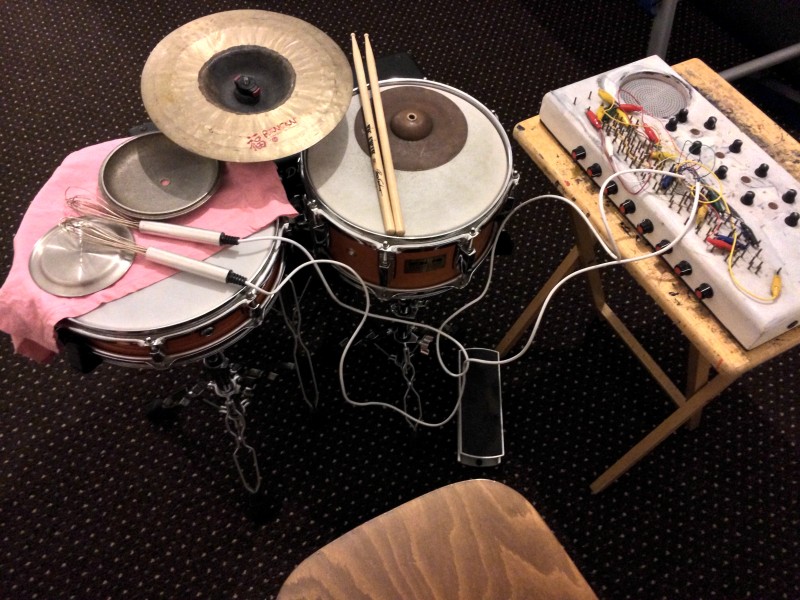
1 x 12″ Pork Pie snare drum
1 x 13″ Pearl snare drum
1 x 12″ Rancan chinese cymbal
1 x 6.5″ toy cymbal
1 x 6.5″ Cast iron pot lid
1 x 4″ Coin dish
1 x Beaker t-shirt
1 x ciat-lonbarde Fourses (Electric Whisks)
1 x Fender Deluxe amplifier
1 x Ernie Ball volume pedal
At this point I hadn’t yet decided on using this as a compositional approach. It was just part of my creative process.
The title of the series of pieces is “Everything. Everything at once. Once.”.
I think it really suits this way of thinking about composition. I don’t know where this compositional approach begins and my normal creative process ends, but I don’t think I will compose a gigantic amount of these pieces. For now, it is something I am exploring.
.com pieces
The .com pieces are a series of pieces I started in early 2013 which are centered around snare drum feedback and form/memory as composi(/improvisa)tional material. So far I have finished two of them, iminlovewithanothergirl.com (for snare, microphone and DMX lights) and ialreadyforgotyourpussy.com (for amplified wind instrument and amplified snare). The third and final .com piece is in the sketching stages and is as of yet untitled.
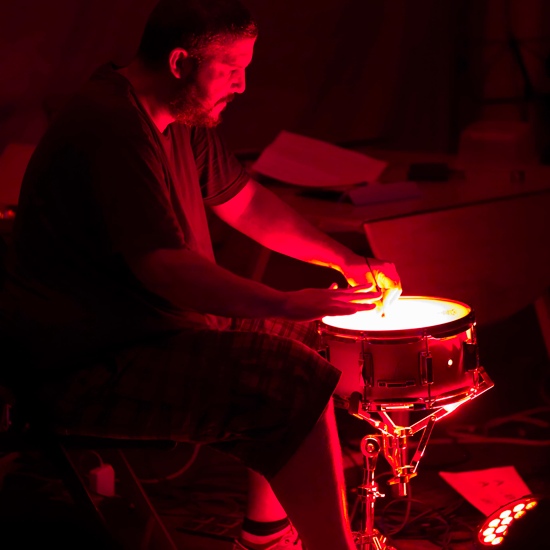
photo by Nick Rutter
Shbobo/Shnth/Ciat-Lonbarde
So back in March I got some funding from my school to bring one of my favorite instrument makers to the UK.
Peter Blasser has been making crazy amazing instruments for years now, and I’ve been using them from the point they were first available as kits (the original Fourses/Fyrall).
Peter has started a new company focusing on digital/embedded instruments, the first of which is the Shnth. I can attest to it’s kickass-ness.
Check out all the links to learn more about it, but this post is mainly about two videos. The first is an excerpt from a performance Peter and I did. The second is an amazing documentary (by Angela Guyton) about the workshop itself.
Flute + Snare
So I’ve been planning a piece for Richard Craig and myself after discovering that he, too, has been working on feedback-based instrument playing. The idea is to follow up my snare/feedback piece, iminlovewithanothergirl.com (score), with a piece for flute/feedback + snare/feedback. This will be the second of a planned trilogy of .com pieces. I’ve been developing a dynamic score display system which I will debut with this piece, but more on that later.
Here are some videos:
strikethrough me & you – Battle Pieces

“Don’t hate the playa, hate the game.” — Ice-T
The Battle Pieces are a series of pieces composed, and performed, with Sam Andreae (as strikethrough me & you) which focus on complex games, improvisational etudes, and competition. The idea for the Battle Pieces came about during a rehearsal of a free-improv duo we had been developing where we decided we wanted to expand on what we were doing together, while still retaining improvisational freedom. This eventually took the form of the Battle Pieces. Essentially each Battle Piece is a game, but beyond being an improv game, it is also competitive, and generally deals with an aspect of improvisation that we want to explore further and/or improve on.
///////////////////////////////////////////////////////////////////////////////////////////////////////////////////////////////////////////////////////////////////////
Battle Pieces
So before I get into the Battle Pieces, it’d be foolish not to start with a yo momma joke.
Yo momma is soooo bad at improv endings that…
strikethrough me & you is a duo with Sam on tenor sax and me on drums. We had each been working on setups that involved solo improv on electronically augmented instruments but wanted to explore something using only stripped-down acoustic instruments. We initially began with just free improv, but during the compositional process of iminlovewithanothergirl.com Sam and I began testing out some of the formal materials (A/B/C pages) from that piece in a duo context. Some of the motivation to do this was to move away from the established canon of tenor sax and drums in free jazz. Those instruments just screamed “FREE JAZZ!” And as we all know, jazz is stupid. This exploration led us to expand and exaggerate the challenge/etude nature of iminlovewithanothergirl.com until the point that it became a competition – a battle.
This led to the idea of a “Battle Piece”: a musical game/challenge where winning and losing had material consequences in the piece. Much like in iminlovewithanothergirl.com, the actual content is not prescribed in any way. In these, the interaction is the composed material of the pieces. It is the idea of interaction as content.
The implementation of game theory in music has a history. Xenakis‘ implementation of game theory in pieces like Duel, although groundbreaking, lacks legibility in terms of the audience perceiving the actual interplay composed into the piece. The mechanics of the piece are primarily focused on balancing the zero-sum characteristics of matrices rather than aesthetics or non-mathematical interplay (Xenakis 1971). That isn’t to say that legibility (of the rules) is terribly important in Battle Pieces, but even the more complex methods of interaction produce legible artifacts, primarily in the form of visible emotion. Much like how it is not necessary to understand the rules of an unfamiliar sport in order to enjoy the game in some manner, the mere fact that there is visible interaction produces a kind of legibility which can be appreciated on its own merit. As Sam put it, “If we work hard enough on the interactions themselves so that we’re clear in them–clear on what our roles are–then it should generate quite strong musical results regardless of whether we tell people how we’re doing it” (Andreae 2013).
The general approach used in Battle Pieces has more in common with Zorn‘s game pieces than they do with Xenakis’. Zorn says of his motivation to create game pieces, which formed most of his compositional output from the late 70s to the early 80s, culminating in Cobra, that he “wanted to find something to harness the personal languages that the improvisers had developed on their own” (Duckworth 1999). So the solution for him was “to deal with form, not with content, with relationships, not with sound” (Duckworth 1999). This idea of relationships, or interaction, is a central concern in the Battle Pieces.
Although I was not directly inspired by the work of Christian Wolff, there is some similarity to the tension and confusion he worked with in his ensemble pieces of the 50s and 60s. Wolff’s use of relational notation, instructing performers to begin before/after a sound they have heard, or play a sound lower/higher in pitch to an existing note, gives the music a sense of immediacy and tension that would not be possible to arrive at another way. Even the pacing of the music is affected by these types of ‘games’, or more simply put by Philip Thomas (a long-time performer of Wolff’s music), “confusion is [used as] a rhythmic device in Wolff’s music” (Thomas 2014).
All Battle Pieces are composed collaboratively during rehearsals, with both of us contributing to the concepts, gameplay, rules, and mechanics of each piece. Although some close friends have tried the pieces out, they are meant to be performed only by Sam and me. The identity of each piece is made up of not only the rules/game/instructions and the type of material we improvise around, which can evolve over time, it is also made up of our personalities. As musicians, performers, and human beings, our personalities and general sense of play make up a big part of the Battle Pieces’ identities.
The core ideas for many Battle Pieces emerge from discussions following free improvisations during strikethrough me & you rehearsals. We sometimes end up finding something about the improvisation that could have been better and link that to tendencies or behaviors that we have as improvisers/performers. This leads to the creation of a piece, or pieces, that tackles that specific aspect of improvisation (endings, space, synchronicity, memory, density, etc.). Through learning, rehearsing, and performing those pieces we improve on the improvisation skills that we had originally found lacking. This process often leads to pieces becoming obsolete as they are no longer challenging or have become part of our general improvisational language and skill set, making the conception/composition/performance/obsolescence of Battle Pieces a microcosm of the feedback loop and intertwinement of my general practice.
The scores that we play from are the instructions for the pieces scribbled onto A4 sheets of paper, as can be seen in the sketches included with each commentary. Since we write the pieces for ourselves there is no need to create thorough notations for each piece, but rather, we jot down a compact set of instructions that we can quickly read to remind ourselves of the rules of the game. A long-term goal, once we have 78 compositions, is to have the instructions for each piece printed on Tarot cards, so that we can shuffle them and pull out cards (pieces) at random during a performance.
In the next section I will present the instructions, sketches, videos and recordings, along with explanations of the instructions, compositional thinking, and performative insight, of the following Battle Pieces:
- yo momma – the creation and baiting/trapping of improvisational endings
- glitch beat – variation/exhaustion, internal/external learning, and repetition
- flurries – spectromorphological acoustic sound masses with fixed compositional elements
- switches – unison playing with encoded/decoded musical information
- eat, eat everything – memory, special events, and in/out/frozen time performance
- sausage fest – space, silence, trajectories, and collective gesture playing
- strains – rock, paper, scissors meets polyrhythmic memory games intertwined with improv
- elbows – the creation of rapid shifts in musical material
- AB(B)A – discovering and transplanting a spontaneous musical games
- pop song – repetition, memory, and form in a freely improvised context
Snare + Microphone
Before I talk, here is some sights and sounds:
During my summer tour last year I improv-ed my way into using a condenser mic as a friction implement. The sounds were harsh, but very controllable and with a great continuity between vastly different types of sounds/playing. I instantly knew I was on to something, and wanted to explore this further.
Fast forward to one month ago.
I was starting to plan/conceive my next composition, having recently started a PhD at the University of Huddersfield, and wanted to explore this microphone/snare thing further. At the same time, I had decided that I was going to move away from the “middle man” of writing a composition, for myself, to perform. (More on this, and the implications of it in a future post). I decided to use this very limited mode of playing as the backbone of this exploration. No other implements, no electronics (other than amplification/distortion), no “easy” solutions to the problem I was trying to solve.
This video is not that solution. It is just a document of some of the sounds and playing techniques I’ve been exploring.
Solo drums + electronics
So I went on a UK tour recently doing solo drums + electronics.
Here is a ‘showreel’ of sorts, documenting some choice bits from the different performances.
This was the first tour I’ve done since moving onto a laptop as my performance setup. The center piece of that is The Party Van, my all-in-one laptop performance solution. It was nice doing a bunch of (relatively) back to back gigs to really get ‘inside’ the mechanics of my patch/setup.
The footage was shot and edited by my wife, Angela Guyton, who shoots most(all) of my videos nowadays. There’s a longer (10minutes) sort of documentary on me in the works covering my live stuff, instrument building, bands, composition etc… Very much looking forward to that.
Weak Without You (new composition)
Weak Without You is my latest composition commissioned by Distractfold Ensemble.
It looks and sounds like this:
It’s written for three female performers who sing and clap (with a bit of a pitched instrument at end). The performers (Linda Jankowska, Emma Richards, and Alice Purton) did a great job with the piece, particularly considering the nakedness of just singing/clapping.
This is the first piece I’ve composed since starting my PhD at the University of Huddersfield and it’s probably one of my simplest/cleanest pieces. The materials are super stark, and I think it really works.
‘Underneath the hood’ there are some further explorations into some of my ideas about ‘fake’ time. Sections B/C/D in the score make use of these ideas, and during the rehearsals the term “real time” and “fake time” were thrown around a lot (to the initial confusion of the performers).
Here is the full score:
Oh yeah, and it’s a ‘cover’ of Survivor by Destiny’s Child….
Musicianship Drills
Here are a couple videos I made for the Art of Teaching project of my favorite drills for working your time and ears.
C-C-Combine
C-C-Combine is a corpus-based audio mosiacing application, built in Max/MSP, based on concatenative synthesis.
It sounds like this:
And looks like this:

A Greater Horror – Debut EP release
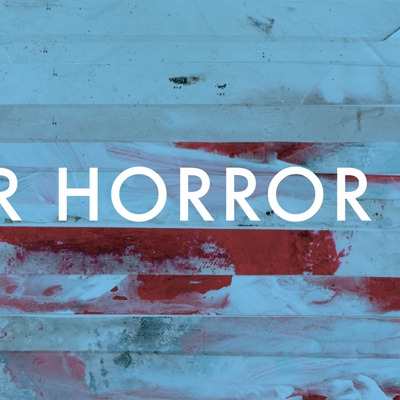
So here it finally is. The post-jazz trio that I’ve been working on with Mauricio Pauly and Alex Tod (A Greater Horror) has finished our debut EP. As always the artwork is by Angela Guyton though this time we’ve gone with a commercially duplicated full-color sleeve type thing.
I’ve very happy with the integration of my software The Party Van into the recording, as all of these tracks were getting gigged before I had even started programming again. You can see/hear more of it in action with the live video we made a bit ago by clicking here.
You can listen to, or buy a download of physical copy of the EP on the bandcamp page here:
Trio with PA Tremblay & Sam Andreae
Had a gig the other night with two of my favorite performers (Pierre Alexandre Tremblay (we just finished recording a followup album) and Sam Andreae.
You can see The Party Van in action on my side, with some more Max/MSP goodness coming from PA. Sam? He kicks it oldschool with some ciat-lonbarde digs, some general DIY grunginess, and with a new school twist, an Arduino.




